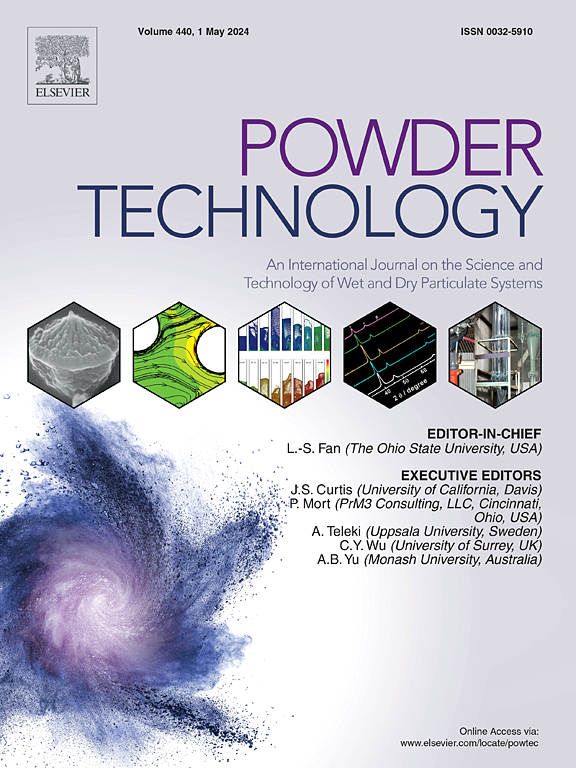DEM simulation of an impact crusher using the fast-cutting breakage model
IF 4.5
2区 工程技术
Q2 ENGINEERING, CHEMICAL
引用次数: 0
Abstract
The impact crusher that exploits impact rather than pressure to break down materials has been widely used in the mineral industry. To further improve its performance in material crushing, numerical simulation capable of providing a deeper insight into the complicated dynamics of feed materials than experimental study has emerged as a promising tool. However, the field of the accurate prediction of product quality and explicit simulation of breakage events inside an industrial-scale crusher remains underexplored on account of the absence of a robust breakage model and heavy computational cost. In this study, a numerical investigation of an industrial-scale crusher using the fast-cutting breakage model is conducted within the DEM (Discrete Element Method) framework. The accuracy of the breakage simulation is quantitatively validated by comparing the predicted results with the measurements from actual production. Furthermore, the influence of operating conditions including the rotation speed of the rotor and the feeding rate on the interested parameters, i.e., the power consumption of the equipment, the size distribution of the products, and the impact-induced wear is investigated comprehensively. The results illustrate that (i) the size of the product increases with the rotor speed until a critical value, after which a further increase in rotor speed will exert no significant influence on the size distribution; (ii) The feeding rate is not a critical operating condition that largely determines the fineness of the product and the efficiency of the equipment almost remain stable under a certain range of feeding rates; (iii) The wear of the devices concentrates on the rotor and the impact plates, and the distribution of the wear exhibits different characteristics in different parts, caused by the complex collision between the particles and the devices.

利用快速切割破碎模型对反击式破碎机进行 DEM 仿真
利用冲击力而非压力破碎物料的反击式破碎机已广泛应用于采矿业。为了进一步提高其在物料破碎方面的性能,与实验研究相比,能够更深入地了解给料复杂动态的数值模拟已成为一种很有前途的工具。然而,由于缺乏可靠的破碎模型和计算成本高昂,对产品质量的准确预测和工业规模破碎机内部破碎事件的明确模拟领域仍未得到充分探索。本研究在 DEM(离散元素法)框架内,利用快速切割破损模型对工业规模的破碎机进行了数值研究。通过将预测结果与实际生产中的测量结果进行比较,对破碎模拟的准确性进行了定量验证。此外,还全面研究了转子转速和进料速度等运行条件对相关参数(即设备功耗、产品粒度分布和冲击引起的磨损)的影响。结果表明:(i) 产品粒度随转子转速的增加而增大,直到一个临界值,之后转子转速的进一步增加对粒度分布没有显著影响;(ii) 进料率不是一个关键的运行条件,它在很大程度上决定了产品的细度,设备的效率在一定的进料率范围内几乎保持稳定;(iii) 设备的磨损集中在转子和冲击板上,磨损的分布在不同部位表现出不同的特征,这是由于颗粒与设备之间的复杂碰撞造成的。
本文章由计算机程序翻译,如有差异,请以英文原文为准。
求助全文
约1分钟内获得全文
求助全文
来源期刊

Powder Technology
工程技术-工程:化工
CiteScore
9.90
自引率
15.40%
发文量
1047
审稿时长
46 days
期刊介绍:
Powder Technology is an International Journal on the Science and Technology of Wet and Dry Particulate Systems. Powder Technology publishes papers on all aspects of the formation of particles and their characterisation and on the study of systems containing particulate solids. No limitation is imposed on the size of the particles, which may range from nanometre scale, as in pigments or aerosols, to that of mined or quarried materials. The following list of topics is not intended to be comprehensive, but rather to indicate typical subjects which fall within the scope of the journal's interests:
Formation and synthesis of particles by precipitation and other methods.
Modification of particles by agglomeration, coating, comminution and attrition.
Characterisation of the size, shape, surface area, pore structure and strength of particles and agglomerates (including the origins and effects of inter particle forces).
Packing, failure, flow and permeability of assemblies of particles.
Particle-particle interactions and suspension rheology.
Handling and processing operations such as slurry flow, fluidization, pneumatic conveying.
Interactions between particles and their environment, including delivery of particulate products to the body.
Applications of particle technology in production of pharmaceuticals, chemicals, foods, pigments, structural, and functional materials and in environmental and energy related matters.
For materials-oriented contributions we are looking for articles revealing the effect of particle/powder characteristics (size, morphology and composition, in that order) on material performance or functionality and, ideally, comparison to any industrial standard.
 求助内容:
求助内容: 应助结果提醒方式:
应助结果提醒方式:


